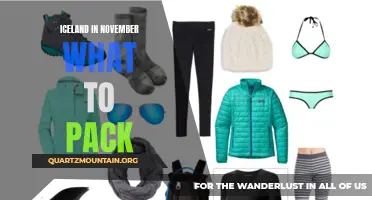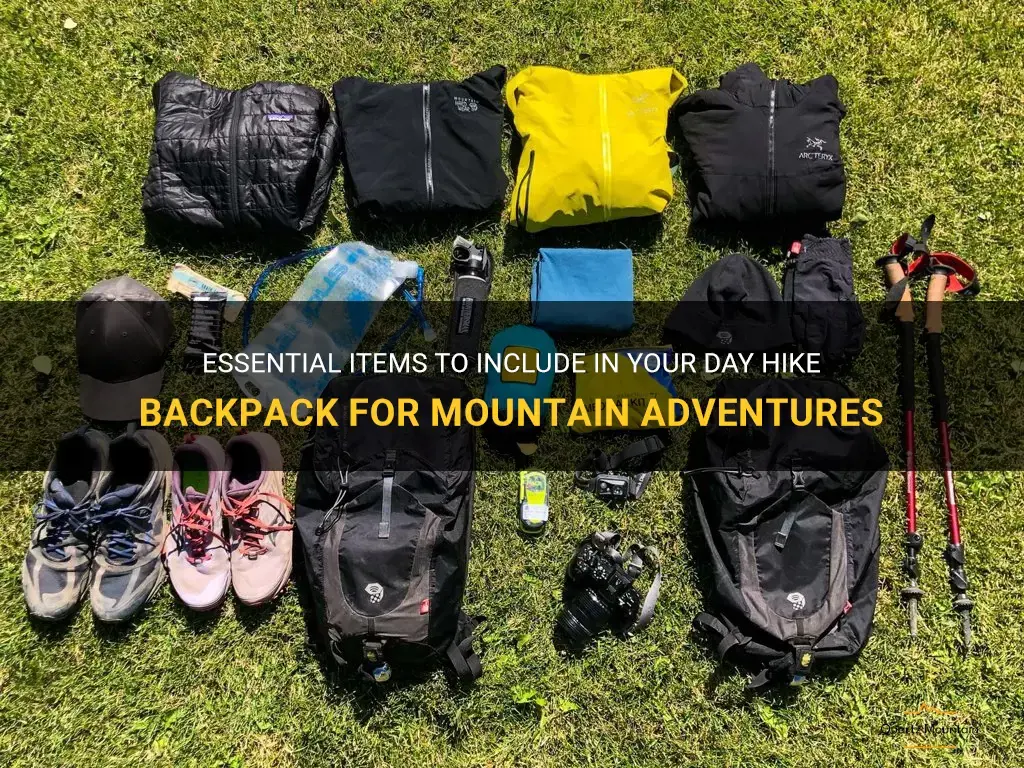
Are you planning a day hike in the mountains? If so, it is essential to pack your backpack with the necessary items for a safe and enjoyable adventure. From water and snacks to navigation tools and emergency supplies, this article will guide you through the essential items to include in your day hike backpack. So, grab your bag and get ready to hit the trails with confidence!
| Characteristic | Value |
|---|---|
| Backpack | Daypack with good support |
| Water | At least 2 liters |
| Food | High-energy snacks |
| Clothing | Layered and weather-appropriate |
| Footwear | Hiking boots or shoes |
| Navigation | Map and compass |
| Sun Protection | Hat, sunglasses, sunscreen |
| First Aid Kit | Basic supplies |
| Knife | Multi-purpose tool |
| Light | Headlamp or flashlight |
| Fire Starter | Matches or lighter |
| Extra Clothing | Insulating layers |
| Rain Gear | Waterproof jacket |
| Communication | Cell phone or radio |
| Emergency Shelter | Lightweight tent or emergency bivy sack |
| Toilet Paper | Biodegradable |
| Personal Items | ID, cash, keys |
| Trash Bag | To pack out waste |
| Trekking Poles | Optional but helpful |
What You'll Learn
- What essential items should I pack for a day hike in the mountains?
- Are there any specific clothing or footwear recommendations for a day hike in the mountains?
- What type of backpack or bag should I use to carry my belongings during a day hike in the mountains?
- Are there any safety gear or emergency supplies that I should include in my pack for a day hike in the mountains?
- Are there any additional items that are recommended or optional to bring for a day hike in the mountains?

What essential items should I pack for a day hike in the mountains?
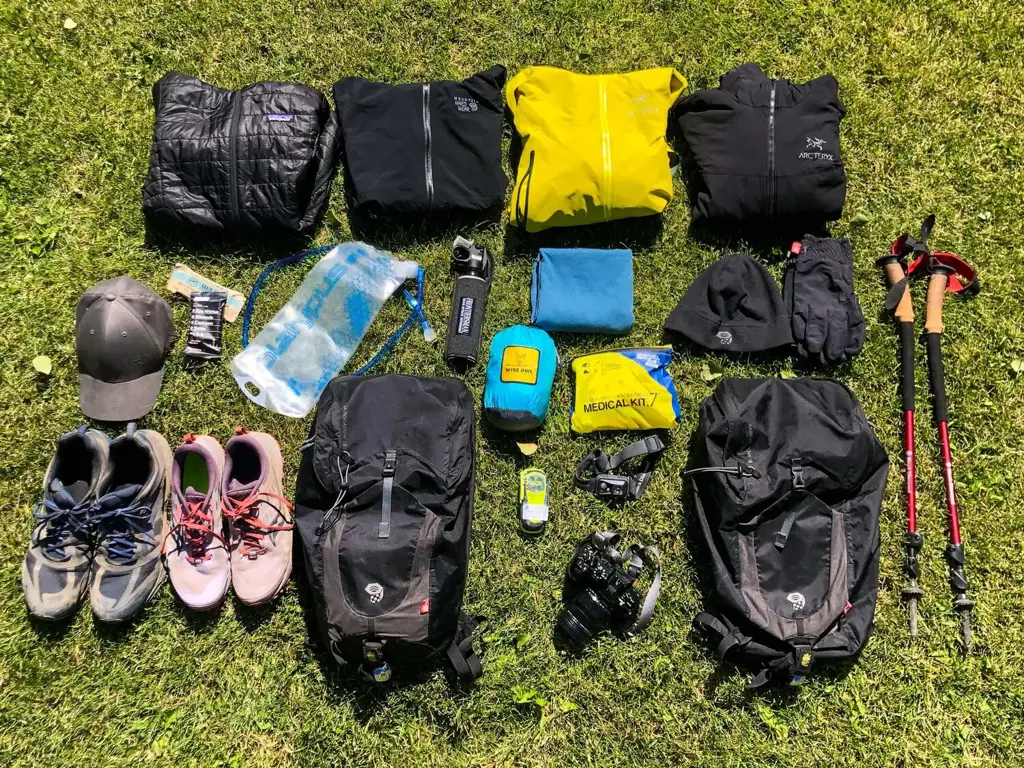
A day hike in the mountains can be an exhilarating and rewarding experience. However, before setting out on your adventure, it is important to ensure that you have packed all the essential items to ensure your safety and comfort. Here is a list of items that you should consider packing for your day hike in the mountains:
- Backpack: A good quality backpack is essential for carrying all your gear. Look for one that is lightweight, has multiple compartments, and a comfortable harness system.
- Maps and Compass: Even if you are familiar with the trail, it is always a good idea to bring a map and compass. These can help you navigate in case you get lost or need to find an alternative route.
- Water: Staying hydrated is crucial when hiking in the mountains. Make sure to pack enough water for the duration of your hike. Consider bringing a water filter or purification tablets in case you run out of water and need to refill from a natural source.
- Food: Pack enough snacks and meals to keep your energy levels up throughout the day. Opt for lightweight, high-energy foods such as trail mix, energy bars, and dehydrated meals.
- Clothing: Dress in layers to be prepared for changing weather conditions. A moisture-wicking base layer, insulating mid layer, and waterproof outer layer are recommended. Don't forget to bring a hat, gloves, and extra socks.
- First Aid Kit: Accidents can happen, so it's important to have a basic first aid kit with you. Include items such as band-aids, blister pads, pain relievers, antiseptic wipes, and any necessary prescription medications.
- Sun Protection: The higher altitude in the mountains means greater sun exposure and increased risk of sunburn. Pack sunscreen with a high SPF, sunglasses, a wide-brimmed hat, and lip balm with SPF.
- Navigation Tools: A GPS device or smartphone with a hiking app can be incredibly useful for navigation and tracking your progress. Just make sure to bring a backup power source or extra batteries.
- Headlamp or Flashlight: Even if you plan on returning before dark, it's a good idea to carry a headlamp or flashlight in case your hike takes longer than expected. It can also come in handy if you need to signal for help.
- Emergency Shelter: A lightweight emergency shelter, such as a bivy sack or emergency blanket, can provide crucial protection in case you get stranded or injured and need to spend the night outdoors.
- Multi-tool or Knife: A multi-tool or knife can be useful for various tasks such as food preparation, gear repairs, and first aid.
- Whistle: A compact whistle can be a lifesaver in an emergency situation, as it can help rescuers locate you more easily.
- Extra Cash and ID: It's always a good idea to carry some extra cash and identification in case of emergencies or unforeseen circumstances.
- Personal Locator Beacon (PLB): If you plan on hiking in remote areas or challenging terrain, consider investing in a personal locator beacon. This device can send out a distress signal and help rescuers locate you quickly.
Remember, the items mentioned above are just a starting point. You should tailor your packing list to your specific needs, the duration and difficulty of the hike, and the local weather conditions. It's also important to check the hiking regulations and recommendations for the specific mountain range you'll be exploring. Proper planning and preparation are key to a safe and enjoyable day hike in the mountains.
Essential Items to Pack for a Memorable Trip to Manu
You may want to see also

Are there any specific clothing or footwear recommendations for a day hike in the mountains?

Hiking in the mountains can be a thrilling and challenging experience. It offers breathtaking views and an opportunity to connect with nature. However, to fully enjoy your day hike in the mountains, it is important to wear the right clothing and footwear. In this article, we will discuss some specific recommendations for clothing and footwear for a day hike in the mountains.
Clothing Recommendations:
Layering is key when it comes to dressing for a day hike in the mountains. The temperature in the mountains can vary greatly, so it is important to be prepared for changing weather conditions. Here are some clothing recommendations for a day hike in the mountains:
- Base Layer: Start with a moisture-wicking base layer. This will help keep you dry by wicking away sweat from your body. Avoid cotton as it retains moisture and can make you feel cold.
- Mid Layer: Depending on the temperature, add a mid layer for insulation. A fleece or a lightweight down jacket is a good option. This layer will help keep you warm when the temperature drops.
- Outer Layer: Your outer layer should be windproof and waterproof to protect you from the elements. A breathable rain jacket or a shell is ideal for this layer. Look for one with vents to help regulate your body temperature.
- Pants: Opt for a pair of hiking pants or convertible pants that can be worn as shorts. Choose pants made of quick-drying and durable material. They should also have some stretch for unrestricted movement.
- Socks: Wear a pair of moisture-wicking socks that provide cushioning and support. Avoid cotton socks as they can cause blisters. Merino wool or synthetic materials are good options.
- Hat and Gloves: Don't forget a hat to protect your head from the sun or cold. In cooler weather, wear gloves to keep your hands warm.
Footwear Recommendations:
Choosing the right footwear is crucial for a day hike in the mountains. Here are some footwear recommendations:
- Hiking Boots: Invest in a pair of sturdy hiking boots that provide ankle support. Look for boots with a good tread and waterproofing. Make sure they are comfortable and properly broken in before your hike.
- Socks: As mentioned earlier, wear moisture-wicking socks that provide cushioning and support. Choose socks that are suitable for the season and temperature of your hike.
Other Important Considerations:
In addition to clothing and footwear, there are a few other things you should consider for a day hike in the mountains:
- Backpack: Carry a backpack that is comfortable and has enough room to store your essentials such as water, snacks, extra layers, and a map or compass.
- Sun Protection: Apply sunscreen before your hike and wear sunglasses and a hat to protect yourself from the sun's harmful rays.
- Hydration: Stay hydrated by carrying an adequate amount of water or a water filtration system.
- Trekking Poles: Consider using trekking poles for added stability and to reduce the strain on your knees and joints.
In conclusion, dressing appropriately for a day hike in the mountains is essential for your safety and comfort. Follow these clothing and footwear recommendations, and don't forget to pack the necessary gear. Remember to check the weather forecast before your hike and adjust your clothing accordingly. With the right preparation, you can fully enjoy your day hike and make lasting memories in the mountains.
Creative Examples of What to Pack in Wooden Crates
You may want to see also

What type of backpack or bag should I use to carry my belongings during a day hike in the mountains?
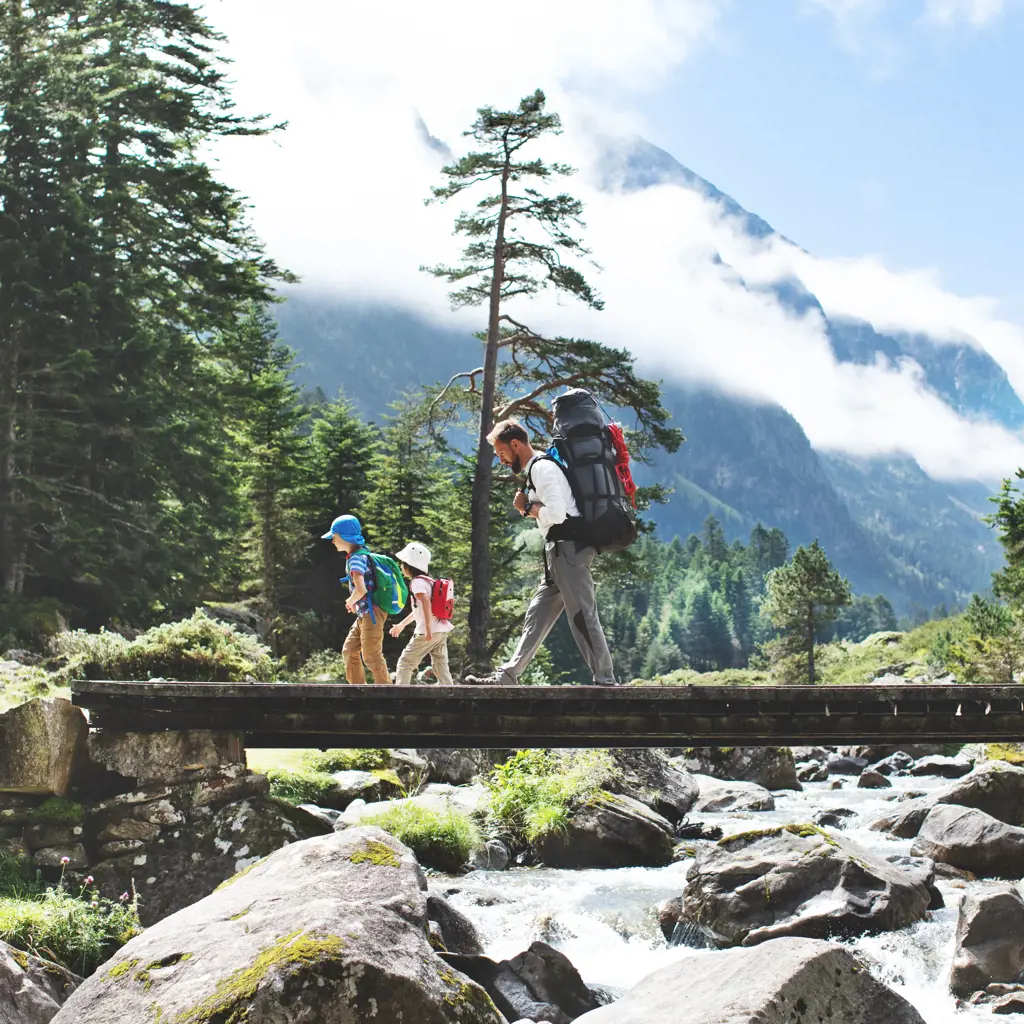
When planning a day hike in the mountains, choosing the right backpack or bag to carry your belongings is crucial. It not only affects your comfort during the hike but also plays a significant role in your overall hiking experience. In this article, we will discuss the different types of backpacks and bags available for day hikes in the mountains and provide you with some tips on how to choose the best one for your needs.
Size and Capacity:
The size and capacity of the backpack are important factors to consider when selecting one for a day hike. A day hike usually requires a smaller backpack compared to a multi-day hiking trip. Look for a pack with a capacity of around 20-30 liters, as it provides enough space to carry essentials such as water, snacks, extra layers of clothing, a first-aid kit, and a camera.
Comfort and Fit:
A comfortable backpack is essential for a pleasant hiking experience. Look for a backpack that has padded shoulder straps, a hip belt, and an adjustable sternum strap. These features help distribute the weight evenly and prevent strain on your shoulders and back. Additionally, choose a backpack with a size that matches your torso length to ensure a proper fit.
Weight:
Keeping the weight of your backpack to a minimum is crucial for day hikes to avoid unnecessary strain on your body. Look for lightweight backpacks made of durable materials such as ripstop nylon or Cordura. These materials are both lightweight and durable, providing a good balance between strength and weight.
Organizational Features:
Having a well-organized backpack can make it easier to access your belongings on the trail. Look for a backpack with multiple compartments, pockets, and attachment points. This will help you keep your gear organized and easily accessible. Consider a backpack with side pockets for water bottles or external straps for attaching trekking poles.
Weather Resistance:
Even if you're hiking on a clear day, the weather in the mountains can be unpredictable. Look for a backpack made of water-resistant material or one that comes with a rain cover. This will protect your belongings from getting wet in case of rain or snow.
Ventilation:
When hiking in the mountains, you're likely to work up a sweat. Look for a backpack with a well-ventilated back panel to keep you cool and prevent excessive sweating. Some backpacks come with mesh panels or suspension systems that allow airflow, keeping your back dry and comfortable.
Examples of Backpacks for Day Hikes in the Mountains:
- Osprey Stratos 24: This backpack offers a comfortable fit, excellent ventilation, and multiple pockets for organization. It also comes with a rain cover for added weather protection.
- Deuter Speed Lite 22: This lightweight backpack is ideal for day hikes in the mountains. It features a minimalist design, padded shoulder straps, and a breathable back panel.
- The North Face Borealis Backpack: This backpack offers a large capacity and multiple compartments for organization. It also comes with an adjustable sternum strap and a padded hip belt for added comfort.
In conclusion, choosing the right backpack or bag for a day hike in the mountains is essential for a comfortable and enjoyable experience. Consider factors such as size, comfort, weight, organizational features, weather resistance, and ventilation when selecting a backpack. With the right backpack, you can confidently hit the trails and make the most of your hiking adventure.
Packing Essentials for an Unforgettable Adventure in Sun Valley
You may want to see also

Are there any safety gear or emergency supplies that I should include in my pack for a day hike in the mountains?
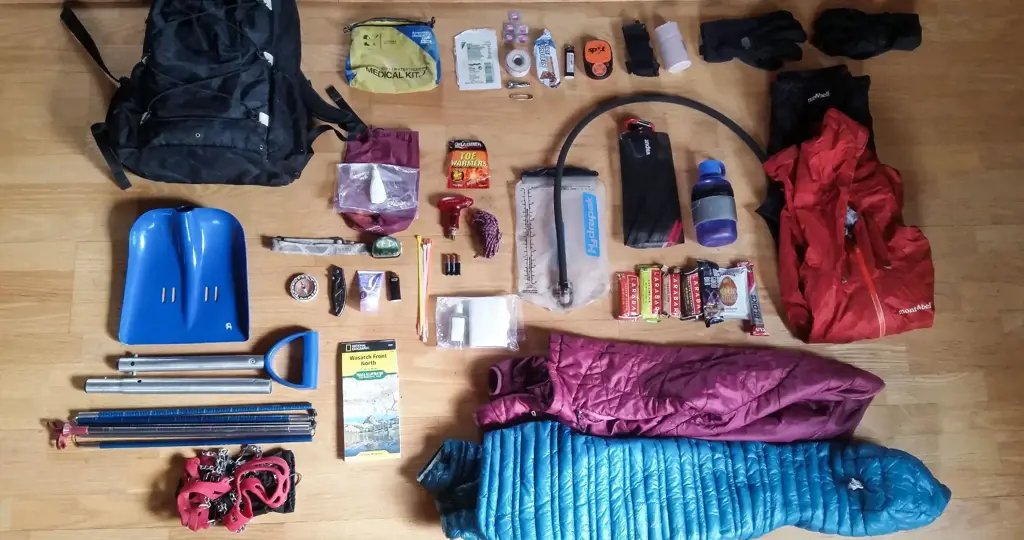
When embarking on a day hike in the mountains, it is important to be prepared for any unforeseen circumstances. While day hikes may seem relatively safe, the mountainous terrain and remote locations can pose potential risks. Therefore, it is advisable to include safety gear and emergency supplies in your pack to ensure your well-being. Here are some essential items to consider including:
- First Aid Kit: A good-quality, comprehensive first aid kit should be the first thing on your list. It should include bandages, adhesive tape, antiseptic wipes, pain relievers, and any additional medication you may require.
- Navigation Tools: Even if you are familiar with the area, it is wise to carry a map, compass, or GPS device to navigate through the mountains. These tools can help you stay on track and avoid getting lost.
- Emergency Shelter: A lightweight emergency shelter, such as a bivy sack or emergency blanket, can provide protection from unexpected weather conditions. It can keep you warm and shielded from rain, wind, or other elements if you get stranded.
- Extra Clothing and Layers: Weather in the mountains can change rapidly and drastically, so it's wise to pack an extra set of clothes. Include warm layers, a waterproof jacket, and a hat to protect yourself from cold temperatures or wet conditions.
- Extra Food and Water: Always bring more food and water than you anticipate needing. Pack high-energy snacks, such as nuts, dried fruit, or energy bars, to keep your energy levels up. Carry a water bottle or hydration pack to stay hydrated throughout your hike. It is essential to stay hydrated at high altitudes to avoid altitude sickness.
- Headlamp and Extra Batteries: In case your hike extends beyond daylight hours, a headlamp is crucial for your safety. It allows you to navigate in low-light conditions and can be a lifesaver if you are caught out after dark. Make sure to pack extra batteries or ensure your headlamp is fully charged.
- Fire-making Tools: Having the ability to start a fire can be essential for warmth, cooking, or signaling for help. Carry waterproof matches, a lighter, or fire-starting materials like magnesium fire starters.
- Whistle and Signal Mirror: These items can be used to alert others to your presence in case of an emergency. A whistle can carry sound over long distances, while a signal mirror can help rescuers locate you by reflecting sunlight.
- Multi-tool or Knife: A multi-tool or knife can come in handy for various purposes, such as repairing gear, cutting rope, or preparing food. Choose a durable and versatile tool that fits comfortably in your pack.
- Personal Locator Beacon (PLB): If you frequently venture into remote or challenging terrain, investing in a PLB can provide an extra layer of security. A PLB is a satellite-based emergency device that can transmit distress signals and help search and rescue teams locate you in the event of an emergency.
Remember, this list is not exhaustive, and you should tailor your safety gear and emergency supplies to your specific needs and the conditions of your hike. Additionally, it's important to carry the appropriate clothing, footwear, and gear specific to your hike's difficulty level and the terrain you will encounter. Always research your hiking route beforehand and inform someone about your plans, including your expected return time. Safety should always be a top priority when venturing into the mountains, even for a day hike.
Essential Items to Pack for 10 Days in Mauritius
You may want to see also

Are there any additional items that are recommended or optional to bring for a day hike in the mountains?
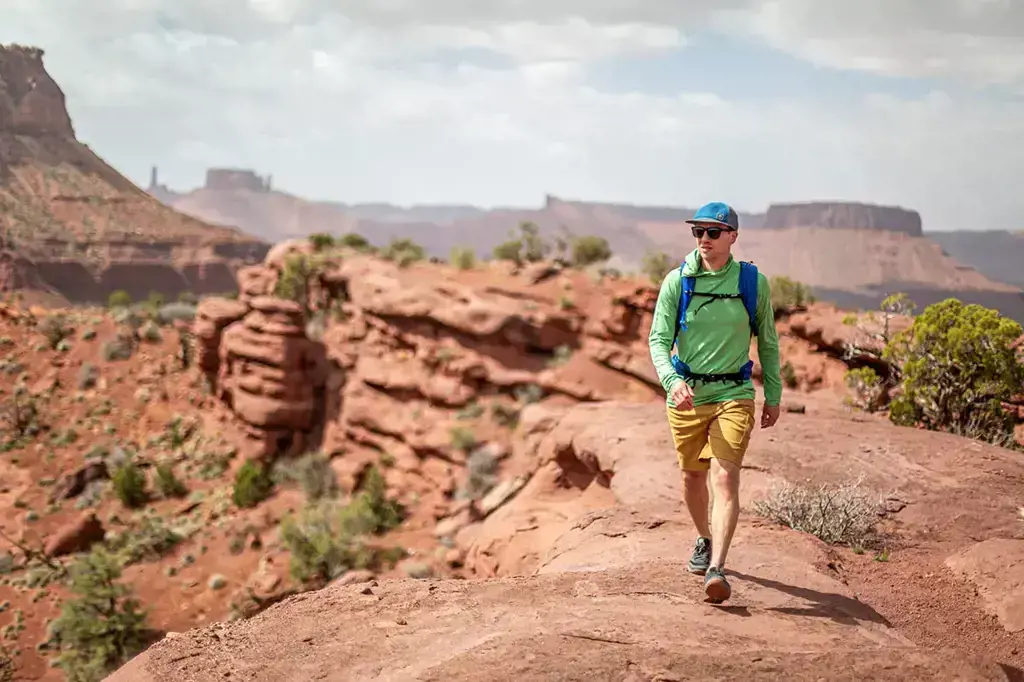
When planning a day hike in the mountains, it is important to pack the essentials to ensure a safe and enjoyable adventure. However, there are also some additional items that are recommended or optional to bring along to enhance your hiking experience. Let's take a look at some of these items:
- Trekking Poles: Trekking poles can be a valuable addition to your hiking gear, especially when tackling steep or challenging terrain. They provide stability and support, helping to reduce strain on your legs and knees. Trekking poles also help to improve balance and can be particularly useful when crossing streams or slippery sections of the trail.
- GPS or Map and Compass: While most popular hiking trails are marked, it is always a good idea to carry a GPS device or a map and compass. These tools will help you navigate in case you get off-trail or encounter unexpected situations. Make sure you are familiar with how to use them before setting off on your hike.
- Extra Clothing Layers: Weather conditions in the mountains can change rapidly, so it is advisable to pack extra clothing layers, even for a day hike. Include a lightweight, waterproof jacket, a warm hat, and gloves in case the temperature drops or it starts to rain. Dressing in layers allows you to adjust your clothing to accommodate changes in weather or activity level.
- First Aid Kit: A basic first aid kit is an essential item to have on any hiking trip. Include items such as band-aids, antiseptic wipes, adhesive tape, gauze pads, tweezers, and pain relievers. Customize your first aid kit based on your specific needs and any medical conditions you may have.
- Snacks and Water: It is crucial to stay hydrated and fueled during your hike. Pack plenty of water and snacks to keep your energy levels up throughout the day. Choose lightweight, high-energy snacks like trail mix, energy bars, or dried fruits. Water sources may not always be available, so it is advisable to carry a water filter or purification tablets to replenish your water supply from streams or lakes if necessary.
- Insect Repellent: Depending on the location and time of year, insects can be a nuisance during a mountain hike. To protect yourself from bites and stings, bring along insect repellent. Look for a product that contains DEET or another effective repellent ingredient.
- Camera: Don't forget to bring a camera or smartphone to capture the beautiful scenery and memories of your hike. Take the time to appreciate the stunning views and wildlife you encounter along the way.
Remember that the weight of your backpack should be manageable, so pack only what you need. It is also important to research the specific trail and area you will be hiking to determine if there are any additional items recommended for that particular location.
By bringing these additional items on your day hike in the mountains, you can further enhance your experience and ensure that you are prepared for any situation that may arise. Always prioritize safety and be mindful of Leave No Trace principles to preserve the beauty of the natural environment for future generations.
Ultimate Guide: Essential Items to Pack for a Man's Lunch
You may want to see also
Frequently asked questions
When heading out for a day hike in the mountains, it's important to pack the essentials. Firstly, make sure you have a good backpack to carry your items. It's a good idea to pack extra clothing layers, as the weather can change quickly in the mountains. Bring a waterproof jacket, a warm hat, gloves, and additional layers such as a fleece or sweater. Don't forget to pack a hat and sunglasses to protect yourself from the sun.
The right footwear is crucial for a day hike in the mountains. Make sure you have a sturdy pair of hiking boots or shoes that provide good support and traction. Opt for boots that are ankle-height for extra stability. It's a good idea to break in your footwear before your hike to avoid blisters and discomfort.
It's important to stay hydrated and energized during your day hike in the mountains. Pack plenty of water and bring a reusable water bottle or hydration bladder. Plan to drink at least 2 liters of water throughout the day. In terms of food, pack lightweight, high-energy snacks such as trail mix, energy bars, and fruits like bananas or apples. It's a good idea to bring more food than you think you'll need, just in case.
In addition to the essentials mentioned earlier, there are a few specific items you should pack for a day hike in the mountains. Bring a map and compass or a GPS device to navigate your trail. It's also a good idea to have a headlamp or flashlight in case your hike takes longer than expected. Don't forget a first aid kit with essentials such as band-aids, adhesive tape, pain relievers, and any necessary prescription medication.
There are a few additional items you might want to pack for a day hike in the mountains. If you're planning a longer hike or hiking in remote areas, consider bringing a lightweight tent, sleeping bag, and camping stove if you plan to cook your own meals. Carry a multi-tool or Swiss Army knife for various purposes. Other optional items include a camera to capture the stunning mountain views, a trekking pole for extra stability, and insect repellent if you're hiking in bug-prone areas.






